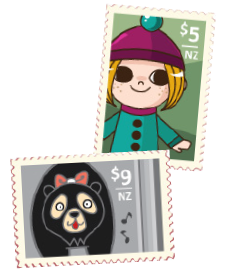This problem solving activity has a number focus.

The Otehaihai Post Shop only sells $5 and $9 stamps for larger letters and for parcels.
What amounts of postage can be made up from these denominations?
- Describe what it means for a sequence to carry on infinitely.
- Look for patterns in linear combinations of numbers.
- Devise and use problem solving strategies (guess and check, make a table, look for patterns).
This problem involves the use of linear combinations of 5 and 9. It also involves understanding that if you have 5 consecutive numbers, then you can produce all subsequent numbers by adding multiples of 5 to those numbers. For example: starting with 23, 24, 25, 26, 27 and adding 5 to each, gives 28, 29, 30, 31, 32. Adding 5 to these gives 33, 34, 35, 36, 37, and so on.
This problem is the third of a series of six problems that develop from a specific stamp problem to a fairly general one. The other problems in this series are $3 and $5 Stamps, Number, Level 3; $4 and $7 Stamps, Number, Level 4; What is s?, Algebra, Level 6; What is t?, Algebra, Level 6; and What is s and t?, Algebra, Level 6.
The Problem
The Otehaihai Post Shop only sells $5 and $9 stamps for larger letters and for parcels. What amounts of postage can be made up from these denominations?
Teaching Sequence
- Discuss mail. Ask:
How often do you or your family post letters?
How else can you communicate with people who are located far away?
Why have postage stamps become more expensive?
Who thinks there will still be letter mail in 5 years? Why do you think that? - Pose the problem to the class.
- As a class list some of the values (5, 9, 5 + 9 etc).
- Have students work on the problem, making it clear that they are looking for some simple way of telling if a number can be made from a combination of 5 and 9 or not. You might suggest that they start at 1, then 2 and so on to see which values they can make.
- If they conjecture that it looks like everything from 32 onwards can be made, ask them if they can justify this. You might need to encourage them to think about what happens when you keep adding 5 to a single number or a set of numbers.
- Share solutions giving a justification for what they have found. Emphasise that the sequence can carry on indefinitely.
- Make the extension problem available.
Extension
How would things change if the stamps were $5 and $11?
Can you guess a general result with two denominations of stamps where one denomination is $5?
Solution
The solution method follows the same pattern as that of $3 and $5 Stamps, Number, Level 3.
A good way to start here is to experiment. For instance, make a table showing the numbers 1 to 50 and put a tick against those that can be made and a cross against those that can’t. What amounts seem to be working are 5, 9, 10, 14, 15, 18, 19, 20, 23, 24, 25, 27, 28, 29, 30, and everything from 32 onward
How can the conjecture be justified? Can you make 32, 33, 34, 35, 36? Yes. Add 5 to each of these and you’ll get 37, 38, 39, 40, 41. But then add 5 to all of these and you’ll get 42, 43, 44, 45, 46. Can you see now that eventually you will get any number you want that is bigger than 32, simply by adding enough fours?
Other methods will work but this is probably the most efficient.
Solution to the Extension
The same approach will work with 5 and 11. Here you can get 5, 10, 11, 15, 16, 20, 21, 22, 25, 26, 27, 30, 31, 32, 33, 35, and everything from 40 onwards.
5 and t is not the same. We suggest you get the students to try various values of t so that they can look for patterns and produce a conjecture. Forget about the small values you can get. They might come up with the conjecture that all numbers that are greater than or equal to 4(t – 1) can be made. That is on the track but doesn’t work if t = 55. In fact you need 5 and t to have no factors in common in order to get 4(t – 1).
A full proof for last conjecture is given in What is t?, Algebra, Level 6.